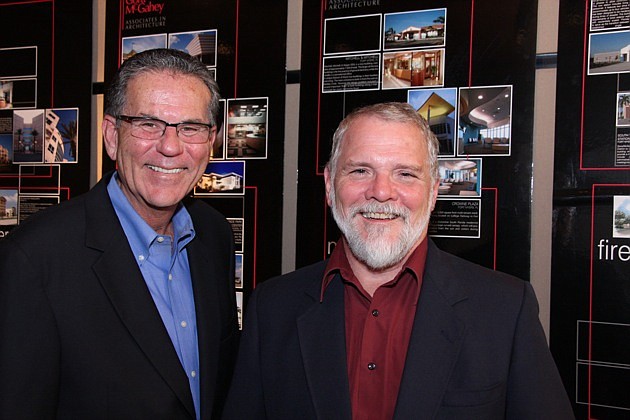REVIEW SUMMARY
Company. Gora McGahey Associates in Architecture
Industry. Architecture
Key. Plan for the worst.
This isn't the kind of lesson they teach you in architecture school.
Bruce Gora, the outgoing, 58-year-old trumpet-playing Fort Myers architect died 18 months ago, leaving behind the firm he had built with business partner Dan McGahey, 57.
It wasn't supposed to work out this way, but the ordeal holds lessons for any business partnership that hopes to live beyond the life of the founders.
Among those are the need for advanced planning, mentoring employees to perpetuate the firm and focusing on serving the client by solving their problems even as dramatic change happens. “Proper planning is what saved this company,” says McGahey.
What's more, Gora's diagnosis of thyroid cancer in September 2006 coincided with the beginning of the economic downturn, which decimated the ranks of architects, engineers, planners and construction companies on the Gulf Coast.
One of the biggest challenges McGahey faced was communicating to employees and clients that the firm would live on after Gora's death. He hired a consultant to help with long-range planning and a marketing firm to help publicize the firm's work through the tumultuous period.
Gora and McGahey even considered changing the company's name. “We went through a protracted discussion of company image,” McGahey says. “Finally, I said no, we have an established brand and people who know our logo.”
Building the team
Gora and McGahey teamed up in 1986, two entrepreneurial architects who foresaw the region's growth and saw opportunity because of the lack of competition.
They made a good team. Gora was the firm's rainmaker, bringing in new business through his relentless networking with chambers of commerce, economic development organizations and charitable endeavors. “He was the marketing element,” McGahey says.
McGahey was the man behind the scenes, making sure existing clients were happy and the work got done. McGahey was more comfortable working with construction teams in the field than networking at society galas like Gora. “That gave me the freedom to be in the back room,” McGahey says, noting that Gora's focus was always on the next project while his was on the last one.
The architects were generalists who designed whatever commercial buildings were needed, whether they were fire stations, medical office buildings or government facilities. Because of Fort Myers' relatively small size and Florida's boom-and-bust economy, Gora and McGahey didn't have the luxury of specializing in a certain type of building design.
“When the economy takes a turn, certain aspects do better than others,” McGahey says.
However, Gora McGahey's reputation with the health-care industry grew as demand for medical services continued through economic ups and downs. Together, they designed more than 100 medical-office projects, from dentistry to podiatry practices.
As their firm grew, both Gora and McGahey planned for the possibility that one of them might die. They purchased “key man” life insurance. The beneficiary was a limited-liability company controlled by McGahey that was used to pay off Gora's estate. “It allowed us to weather the financial storm,” McGahey says.
But when they were starting out, McGahey recalls that paying for that insurance was onerous because they were both in good health and in their 30s. “Insurance is something that's a necessary evil,” McGahey says. “It was painful when we were 35.”
Still, Gora and McGahey knew this kind of planning was essential in case something happened to either man. “It took the potential grief out of the picture.”
The diagnosis
Gora was diagnosed with thyroid cancer in September 2006. “We all assumed it was going to be treatable,” McGahey says.
But the disease turned out to be more virulent and Gora began informing clients and others that he had been diagnosed.
Still, Gora regularly came to the office until just before he died, sharing his insights and participating in strategy sessions. “It wasn't an excuse for him,” McGahey says.
More important, Gora and McGahey had organized their firm so that projects could move forward without getting bottlenecked in the corner office. Especially during the boom, there was no way for Gora or McGahey to personally supervise the 20 projects they managed at a time.
“People had such a connection with us that we were able to let Bruce go,” McGahey says. “I was able to focus on the task at hand and move the business forward.”
In fact, that's just what the firm did. “We basically fired Bruce,” McGahey says. Gora had disability insurance that allowed him to earn a living while paying for his treatments.
McGahey acknowledges the difficulty of speaking with his partner about the likelihood of his death. “I was in denial and continued to pray for his recovery,” he says. “We danced around it.”
The partners changed the firm's corporate status from a “C” corporation to a limited-liability company to make it easier for successful employees to gradually buy an ownership stake. “That was the succession plan,” McGahey says.
But even as this was happening, the economy was taking a turn for the worse and employees had to focus on survival rather than succession.
So the firm hired a consultant to help the architects do some long-range planning and a marketing firm to promote the company's brand.
Team effort
In the months that followed Gora's death in December 2008, various organizations staged memorials. At the Alliance for the Arts in Fort Myers, the photos of the firm's projects were displayed on the walls. “It let people know Bruce couldn't have done it alone,” McGahey says.
Gora and McGahey had established their firm by forming teams to handle projects. A project manager leads each team and both men always advise the client that the project manager is the go-to person. “Bruce never took ownership of a project,” McGahey says, noting that Gora always pushed employees to accept the firm's awards at industry banquets.
McGahey says that team approach is why the firm can continue even without one of its founding partners. He reminds employees of the firm's mission: “The task is to solve the problem.”
The economic downturn hasn't made it any easier, though. To adapt to the construction bust, Gora McGahey has focused on doing tenant-improvement work, designing public projects such as fire stations and expanding further away in Orlando and Palm Beach.
Longtime Fort Myers architect Rick McCormack, whose own firm suffered from the downturn in condos and hotels, joined Gora McGahey late last year. Like Gora, McCormack has an outgoing personality and has taken over some of the firm's networking efforts.
“I am not Bruce Gora,” he tells prospective clients, though McGahey says McCormack has allowed him to remain focused on the firm's internal operations.
When the economy comes back, McGahey hopes employees will be able to start buying into the firm. “We're working on that,” he says.






